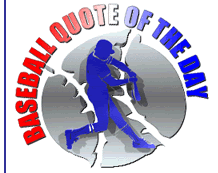Feature Length Quotes and other tidbits |
Features: On Hitting
A letter from Ted Williams
From Ted Williams, Washington Senators, Manager, a four-page letter defining his theories on hitting, sent to Jay Johnstone, OF, California Angels, during the winter of 1968-69, in reply to a letter of request for advice on hitting:
Dear Jay:
There are a few things I think are all-important to anyone, no matter how much ability a fellow has, no matter what style he has, and without ever seeing you, I know this is good solid advice. It is impossible for me to say anything about your swing or how I might help you in this respect, so I am just going to outline what I consider most important in improving anybody's hitting.
When I was a young fellow, back in 1938, I had the great privilege of being acquainted with the greatest right-handed hitter of all times, Rogers Hornsby. He was the only outstanding hitter whom I ever asked, "What do I have to do to be a good hitter?"
Rogers Hornsby said, and after playing professional ball for 25 years myself, I agreed: With all the natural ability and talent in the world, it is impossible to be a really good hitter WITHOUT GETTING A BALL TO HIT! Now, what does that mean?
It means a ball that is not in a tough area for you. It means a ball you are not fooled on, and, of course, I mean this applies only up to two strikes. With two strikes, you simply have to protect the plate. I get a little impatient watching the good hitters today -- fellows with great ability -- who are not as good as they should be simply because they won't wait for the good pitch to hit.
I've been asked how often I got the ball I was looking for. I would say that it was a good 70 percent of the time.
Certainly, you can't improve without practicing the things you know you are weakest in, and the best place to correct them is during batting practice -- CONCENTRATED BATTING PRACTICE -- not just swinging from your ass. You should analyze what you are doing with every pitch. If you find that you pop up the high pitch, then your thought on the next pitch should be "I have to be quicker," because, as a rule, when you pop up a pitch, your bat has been slow. So you say, "I have to be quicker," and you also have to think about hitting down on the ball. No matter what type of pitch it is, if you haven't hit it solidly, you should immediately think of the correction you have to make.
Whenever I went into a slump, I went back to fundamentals. Wait on the ball, be quick, use a light bat and choke up. I'm an advocate of the light bat, and I'm sure that of all of the home runs I hit, at least half of them came when I was choking up slightly.
Just one more thing. Do not try to pull the ball. If you have figured the pitch properly, you are going to get enough pitches that it should be just like batting practice. I'm sure you pull a reasonable amount of balls in practice, so you should never make an effort to do it. It should come naturally.
The point is that anybody is a better hitter when he is not pulling the ball. Take an imaginary swing as if you were trying to pull. You can see that the angle decreases your hitting zone. It becomes a more critical way of meeting the ball solidly.
I certainly wish you a lot of luck and am glad to know that Jimmy Piersall has been helping you.
Sincerely,
Ted Williams
Contributed by Lee Gibbs

| If you have any suggestions or any favorite baseball quotes please drop us a note at quotes@webcircle.com |